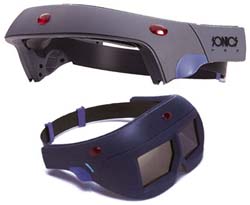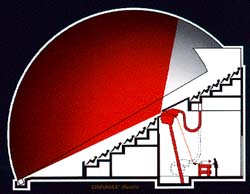
 |
The IMAX digital sound system was developed by Sonics Associates of Birmingham, Alabama. In 1988, Lynn McCroskey and Jim Cawhon developed a Digital Disc Playback system (DDP) that recorded 2 channels of uncompressed digital sound on an audio compact disc. This system with 3 discs and 6 channels began to replace the multitrack magnetic tape sound systems used in IMAX theaters since 1971. In 1993, Sonic introduced the IMAX 3D sound system with 10 channels for the Sony IMAX theater in New York. Theater speakers produce 8 channels from 4 CD disks synchronized with the15-perforation 70 mm filmstrip running through the projector horizontally past a 15,000-watt lamp at 48 frames per second. The 3D headset has 2 additional channels for the binaural Personal Sound Environment (PSE). "Binaural sound emanates from the headsets' two small speakers, just above and slightly in front of your ears; they cover all but the frequencies below 100 Hz. Low bass is handled by a pair of subwoofers behind the giant screen. Four full-range speakers, also behind the screen, keep sounds tied solidly to the
 |
Lynn McCroskey is President and CEO of Sonics Associates, a subsidiary of Toronto's IMAX Corporation. In an interview with Millimeter magazine, he explained the difference between the IMAX sound system and the surround systems in conventional theaters: "The typical IMAX screen is close to a conventional 4:3 aspect ratio, but much, much bigger. So you have a great deal of vertical, which gives you the opportunity to do a 'voice-of-God' loudspeaker." Another difference is the use of point-source surround, as opposed to the multiple small surround speakers used in conventional theaters. "Conventional rooms," McCroskey says, "come in so many different shapes that it is nearly impossible for them to make point-source surround work." Overall IMAX system power varies depending on the size of the room, but it is typically in the range of 12,500 watts. "The power is not there for the loudness," McCroskey says. "It's there for clarity and freedom from distortion." The enclosures are three-way systems using components custom-designed and manufactured to Sonics' specifications. Sonics combines four low-frequency loudspeakers in each cabinet with nested high- and mid-frequency horns. McCroskey points out the trapezoidal dispersion pattern (narrower at the top than the bottom), designed to match the distinctive shape of IMAX theaters. Using a sub-bass system for the deepest lows, McCroskey says, minimizes phase coherence problems. "In most installations, we use eight sub-bass loudspeakers, each in a 16-cubic-foot enclosure," he says. "The enclosures include a filtering labyrinth we designed that physically traps the higher-frequency components that can otherwise cause overtones and distortion."
 |
Another distinction between IMAX and other theater surround systems is that Sonics uses no digital audio data compression. Both the DDP and DTAC lines are full fidelity, "double-system" approaches, meaning that the sound is not recorded on the film itself. "DDP uses three CD-Audio discs with a patented sample-accurate playback synchronization system," McCroskey says. DTAC, the company's newest system, plays back audio files either from DVD-ROM or from a built-in hard disk. In some older IMAX theaters, the original 35mm six-track, full-coat mag-sound system used from 1971 through 1988 is still in place. "These days most soundtracks are produced in digital formats," McCroskey says. "They are usually sent in on TASCAM DA-88, and we transfer to whatever format is needed for the theaters where the film will play. On Everest, for instance, we created both DDP and DTAC discs." Everest was the first IMAX film where the final mix was done on location in an IMAX theater, the Irvine Spectrum. That meant the mixers did not have to make several rounds of notes while watching the film and then implement changes back at the EFX dub stage. But they did have to set up facilities in a working theater that was not available until 10 at night (after the day's last screening). They worked from a 24-track premix made at EFX with six tracks each for effects, backgrounds, and music; three for Foley; and one each for narration, voice-overs, and dialog. EFX made a discrete premix to 24 tracks: six each for effects, backgrounds, and music; three for Foley; and one each for narration, voice-overs, and dialog. (quote from Millimeter article by Philip De Lancie)